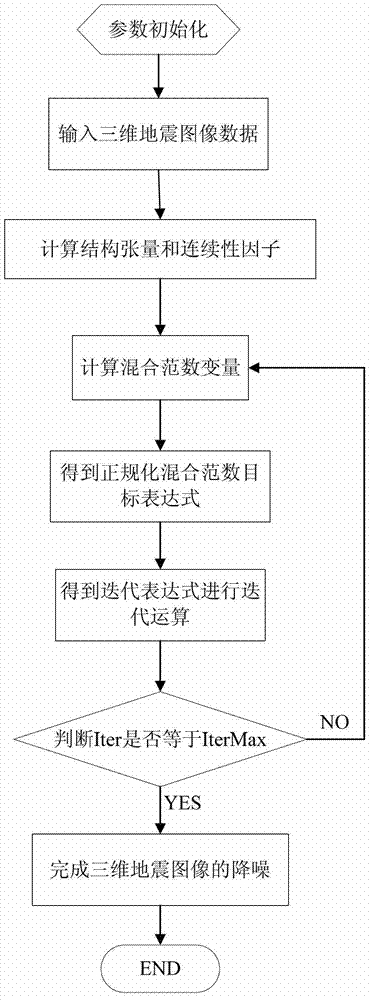De-noising processing method for three-dimensional seismic images
A three-dimensional seismic and noise reduction technology, applied in image data processing, image enhancement, instruments, etc., can solve the problems of the theoretical analysis and numerical calculation of the image noise reduction process, and achieve obvious adaptability, improved noise reduction effect, and automatic performance. Adaptive and accurate effects
- Summary
- Abstract
- Description
- Claims
- Application Information
AI Technical Summary
Problems solved by technology
Method used
Image
Examples
Embodiment Construction
[0033] A noise reduction processing method for 3D seismic images, such as figure 1 shown, including the following steps:
[0034] Step 1. Parameter initialization (including the setting of the number of iterations, Iter=0), input 3D seismic image data;
[0035] Step 2: Establish a degradation model and calculate the degradation matrix H:
[0036] The quality degradation of seismic images is called degradation, and the forms of degradation include blurring, distortion, and noise. The image degradation process can be regarded as the noise pollution process, and the degradation model is as follows:
[0037]
[0038] According to the above degradation model, the degraded image is obtained as:
[0039] g(x,y,z)=H f(x,y,z)+n(x,y,z)(2-1)
[0040] Among them, f(x,y,z) is the original image, g(x,y,z) is the degraded image, H[] is a function of all degradation factors, and n(x,y,z) is the noise.
[0041] We make the following assumptions about H:
[0042] ①H is linear.
[0043] ...
PUM
 Login to View More
Login to View More Abstract
Description
Claims
Application Information
 Login to View More
Login to View More - R&D
- Intellectual Property
- Life Sciences
- Materials
- Tech Scout
- Unparalleled Data Quality
- Higher Quality Content
- 60% Fewer Hallucinations
Browse by: Latest US Patents, China's latest patents, Technical Efficacy Thesaurus, Application Domain, Technology Topic, Popular Technical Reports.
© 2025 PatSnap. All rights reserved.Legal|Privacy policy|Modern Slavery Act Transparency Statement|Sitemap|About US| Contact US: help@patsnap.com



